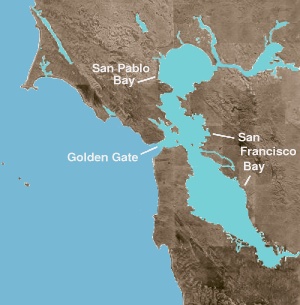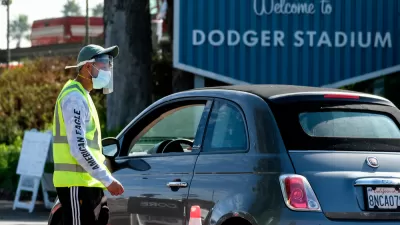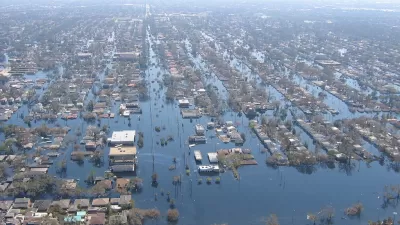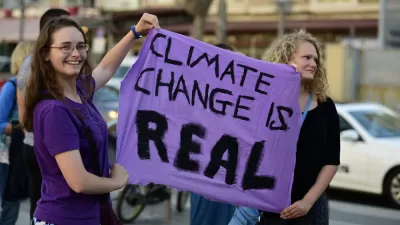Officials have begun tackling the problem of adapting low-lying State Route 37 in the North Bay, closed several times this year due to flooding, to climate change. With no identified funding, a working group is leaning toward road tolling.
On April 28, Gov. Jerry Brown signed a $52 billion transportation funding plan based on a the largest gas tax increase in state history, but with no funds earmarked for repairing Highway 37, one of the lowest-lying highways and most threatened by climate change and sea level rise in California.


Credit: Wikipedia: San Pablo Bay, shown with San Francisco Bay
"A fee-based future appears to be gaining traction with a key advisory group tasked with long-term solutions for traffic and flooding on the heavily traversed 21-mile highway from Vallejo [Solano County] to Novato [Marin County]," reports Derek Moore for The Press Democrat.
“I think everyone acknowledges there’s few options other than tolls to generate revenue needed to do a project of that scale in that location,” said Sonoma County Supervisor David Rabbitt, chairman of the Highway 37 Policy Committee.
"The State Route 37 Policy Committee is a multi-county committee with policy makers participating from Marin, Napa, Sonoma and Solano counties," notes the Transportation Authority of Marin.
The SR 37 Policy Committee was formed in 2015 as part of a Memorandum of Understanding (pdf) to discuss joint county efforts in improving the SR 37 Corridor to address sea level rise, traffic congestions, transit options and recreational activities.
A January Press-Democrat editorial warned that the flooding of the roadway "could be a glimpse of what climate change and rising sea levels have in store for the North Bay."
Moore reports on a meeting [pdf] held May 4 by the policy committee
"A consultant hired by the policy group to address options for Highway 37 improvements — ranging from building a seawall to an elevated causeway — said paying for the work boils down to charging tolls or waiting for Caltrans to identify funding for the work," writes Moore. That could be as late as 2088, noted one committee member.
By contrast, such work could be completed in as little as eight years by charging tolls and by public agencies partnering with private companies [i.e., a public-private partnership] on construction, according to José Luis Moscovich, executive vice-president of Project Finance Advisory Limited, a San Francisco-based consultancy.
“What you have is the possibility of breaking loose from the normal constraints in terms of funding a transportation project in the state,” Moscovich said.
One tolling option would have the state relinquish the right-of-way to a private investment firm "which would fund the construction and charge a toll to recoup its cost." Moore writes about the skepticism expressed by some committee members on pursuing this route.
A report from the Sierra Club's Redwood Chapter indicates that tolls are likely, "with some of the money generated [used] to subsidize [commuter] van services." They express support for tolling and transit options in the corridor.
FULL STORY: Bay Area officials eye future tolls as way to upgrade troubled Highway 37

Planetizen Federal Action Tracker
A weekly monitor of how Trump’s orders and actions are impacting planners and planning in America.

Congressman Proposes Bill to Rename DC Metro “Trump Train”
The Make Autorail Great Again Act would withhold federal funding to the system until the Washington Metropolitan Area Transit Authority (WMATA), rebrands as the Washington Metropolitan Authority for Greater Access (WMAGA).

The Simple Legislative Tool Transforming Vacant Downtowns
In California, Michigan and Georgia, an easy win is bringing dollars — and delight — back to city centers.

The States Losing Rural Delivery Rooms at an Alarming Pace
In some states, as few as 9% of rural hospitals still deliver babies. As a result, rising pre-term births, no adequate pre-term care and harrowing close calls are a growing reality.

The Small South Asian Republic Going all in on EVs
Thanks to one simple policy change less than five years ago, 65% of new cars in this Himalayan country are now electric.

DC Backpedals on Bike Lane Protection, Swaps Barriers for Paint
Citing aesthetic concerns, the city is removing the concrete barriers and flexposts that once separated Arizona Avenue cyclists from motor vehicles.
Urban Design for Planners 1: Software Tools
This six-course series explores essential urban design concepts using open source software and equips planners with the tools they need to participate fully in the urban design process.
Planning for Universal Design
Learn the tools for implementing Universal Design in planning regulations.
Smith Gee Studio
City of Charlotte
City of Camden Redevelopment Agency
City of Astoria
Transportation Research & Education Center (TREC) at Portland State University
US High Speed Rail Association
City of Camden Redevelopment Agency
Municipality of Princeton (NJ)





























